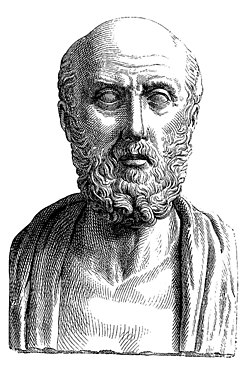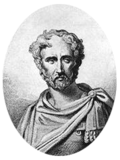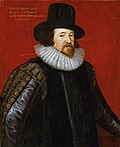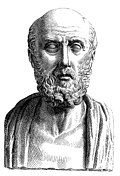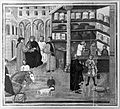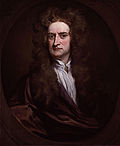Portal:History of science
The History of Science Portal
The history of science covers the development of science from ancient times to the present. It encompasses all three major branches of science: natural, social, and formal. Protoscience, early sciences, and natural philosophies such as alchemy and astrology that existed during the Bronze Age, Iron Age, classical antiquity and the Middle Ages, declined during the early modern period after the establishment of formal disciplines of science in the Age of Enlightenment.
The earliest roots of scientific thinking and practice can be traced to Ancient Egypt and Mesopotamia during the 3rd and 2nd millennia BCE. These civilizations' contributions to mathematics, astronomy, and medicine influenced later Greek natural philosophy of classical antiquity, wherein formal attempts were made to provide explanations of events in the physical world based on natural causes. After the fall of the Western Roman Empire, knowledge of Greek conceptions of the world deteriorated in Latin-speaking Western Europe during the early centuries (400 to 1000 CE) of the Middle Ages, but continued to thrive in the Greek-speaking Byzantine Empire. Aided by translations of Greek texts, the Hellenistic worldview was preserved and absorbed into the Arabic-speaking Muslim world during the Islamic Golden Age. The recovery and assimilation of Greek works and Islamic inquiries into Western Europe from the 10th to 13th century revived the learning of natural philosophy in the West. Traditions of early science were also developed in ancient India and separately in ancient China, the Chinese model having influenced Vietnam, Korea and Japan before Western exploration. Among the Pre-Columbian peoples of Mesoamerica, the Zapotec civilization established their first known traditions of astronomy and mathematics for producing calendars, followed by other civilizations such as the Maya.
Natural philosophy was transformed by the Scientific Revolution that transpired during the 16th and 17th centuries in Europe, as new ideas and discoveries departed from previous Greek conceptions and traditions. The New Science that emerged was more mechanistic in its worldview, more integrated with mathematics, and more reliable and open as its knowledge was based on a newly defined scientific method. More "revolutions" in subsequent centuries soon followed. The chemical revolution of the 18th century, for instance, introduced new quantitative methods and measurements for chemistry. In the 19th century, new perspectives regarding the conservation of energy, age of Earth, and evolution came into focus. And in the 20th century, new discoveries in genetics and physics laid the foundations for new sub disciplines such as molecular biology and particle physics. Moreover, industrial and military concerns as well as the increasing complexity of new research endeavors ushered in the era of "big science," particularly after World War II. (Full article...)
Selected article -

Ancient Chinese scientists and engineers made significant scientific innovations, findings and technological advances across various scientific disciplines including the natural sciences, engineering, medicine, military technology, mathematics, geology and astronomy.
Among the earliest inventions were the abacus, the sundial, and the Kongming lantern. The Four Great Inventions – the compass, gunpowder, papermaking, and printing – were among the most important technological advances, only known to Europe by the end of the Middle Ages 1000 years later. The Tang dynasty (AD 618–906) in particular was a time of great innovation. A good deal of exchange occurred between Western and Chinese discoveries up to the Qing dynasty. (Full article...)
Selected image

Craniometry, the technique of measuring the bones of the skull, was once intensively practiced in anthropology/ethnology. Through the 20th century, craniometry—especially measurements of brain volume—was a matter of considerable; among other misuses, the apparent scientific support of craniometric theories for racism was used to the support the racist ideologies, and ultimately genocidal policies, of the Nazi party.
Did you know
...that the travel narrative The Malay Archipelago, by biologist Alfred Russel Wallace, was used by the novelist Joseph Conrad as a source for his novel Lord Jim?
...that the seventeenth century philosophers René Descartes, Baruch Spinoza, and Gottfried Leibniz, along with their Empiricist contemporary Thomas Hobbes all formulated definitions of conatus, an innate inclination of a thing to continue to exist and enhance itself?
...that according to the controversial Hockney-Falco thesis, the rise of realism in Renaissance art, such as Jan Van Eyck's Arnolfini Portrait (pictured), was largely due to the use of curved mirrors and other optical aids?
Selected Biography -
Hippocrates of Kos (/hɪˈpɒkrətiːz/; Ancient Greek: Ἱπποκράτης ὁ Κῷος, romanized: Hippokrátēs ho Kôios; c. 460 – c. 370 BC), also known as Hippocrates II, was a Greek physician and philosopher of the classical period who is considered one of the most outstanding figures in the history of medicine. He is traditionally referred to as the "Father of Medicine" in recognition of his lasting contributions to the field, such as the use of prognosis and clinical observation, the systematic categorization of diseases, and the (however misguided) formulation of humoral theory. His studies set out the basic ideas of modern-day specialties, including surgery, urology, neurology, acute medicine and orthopedics. The Hippocratic school of medicine revolutionized ancient Greek medicine, establishing it as a discipline distinct from other fields with which it had traditionally been associated (theurgy and philosophy), thus establishing medicine as a profession.
However, the achievements of the writers of the Hippocratic Corpus, the practitioners of Hippocratic medicine, and the actions of Hippocrates himself were often conflated; thus very little is known about what Hippocrates actually thought, wrote, and did. Hippocrates is commonly portrayed as the paragon of the ancient physician and credited with coining the Hippocratic Oath, which is still relevant and in use today. He is also credited with greatly advancing the systematic study of clinical medicine, summing up the medical knowledge of previous schools, and prescribing practices for physicians through the Hippocratic Corpus and other works. (Full article...)
Selected anniversaries
- 1566 - Death of Luca Ghini, Italian physician and botanist (b. 1490)
- 1677 - Death of Isaac Barrow, English mathematician (b. 1630)
- 1733 - Birth of Jean-Charles de Borda, French mathematician, physicist, political scientist, and sailor (d. 1799)
- 1808 - The Royal Netherlands Academy of Arts and Sciences is founded by Louis Bonaparte.
- 1825 - Birth of Thomas Henry Huxley, English biologist (d. 1895)
- 1972 - The Don't Make A Wave Committee, a fledgling environmental organization founded in Canada in 1971, officially changed its name to "Greenpeace Foundation."
- 1972 - Death of Edward Calvin Kendall, American chemist and Nobel Prize laureate (b. 1886)
Related portals
Topics
General images
Subcategories
Things you can do
Help out by participating in the History of Science Wikiproject (which also coordinates the histories of medicine, technology and philosophy of science) or join the discussion.
Associated Wikimedia
The following Wikimedia Foundation sister projects provide more on this subject:
-
Commons
Free media repository -
Wikibooks
Free textbooks and manuals -
Wikidata
Free knowledge base -
Wikinews
Free-content news -
Wikiquote
Collection of quotations -
Wikisource
Free-content library -
Wikiversity
Free learning tools -
Wiktionary
Dictionary and thesaurus

